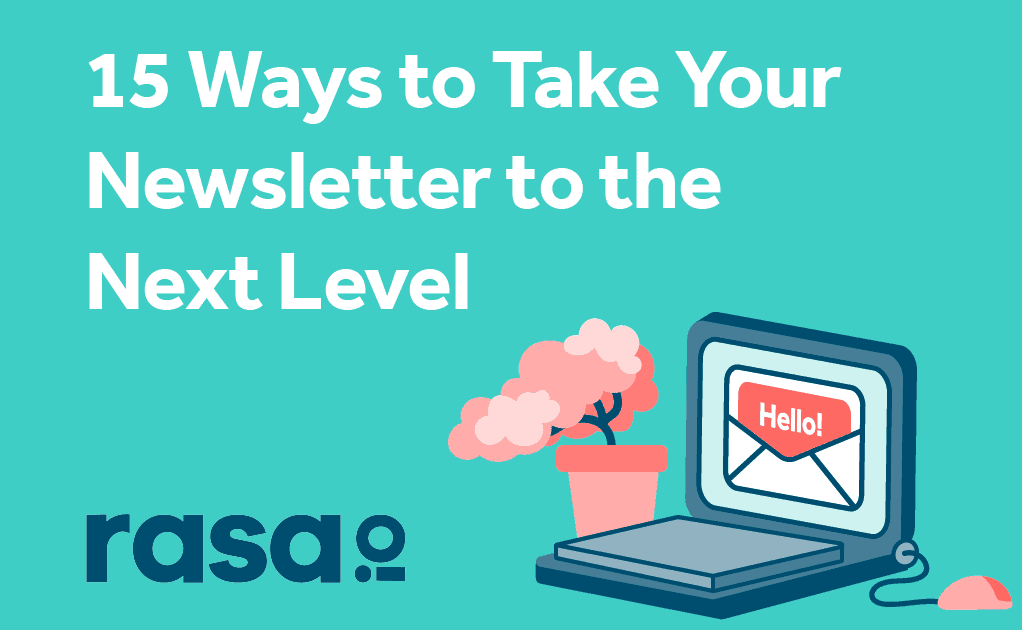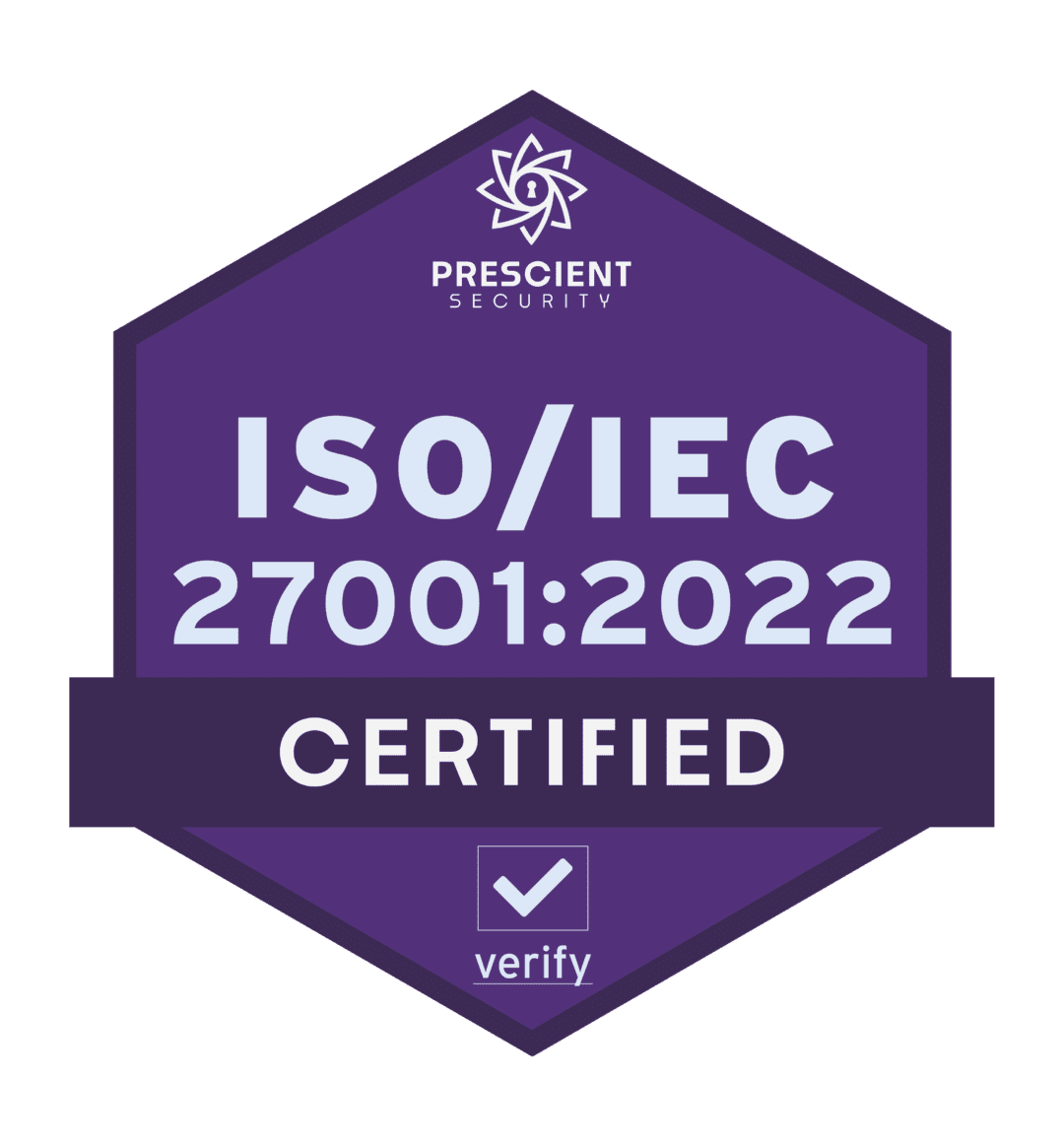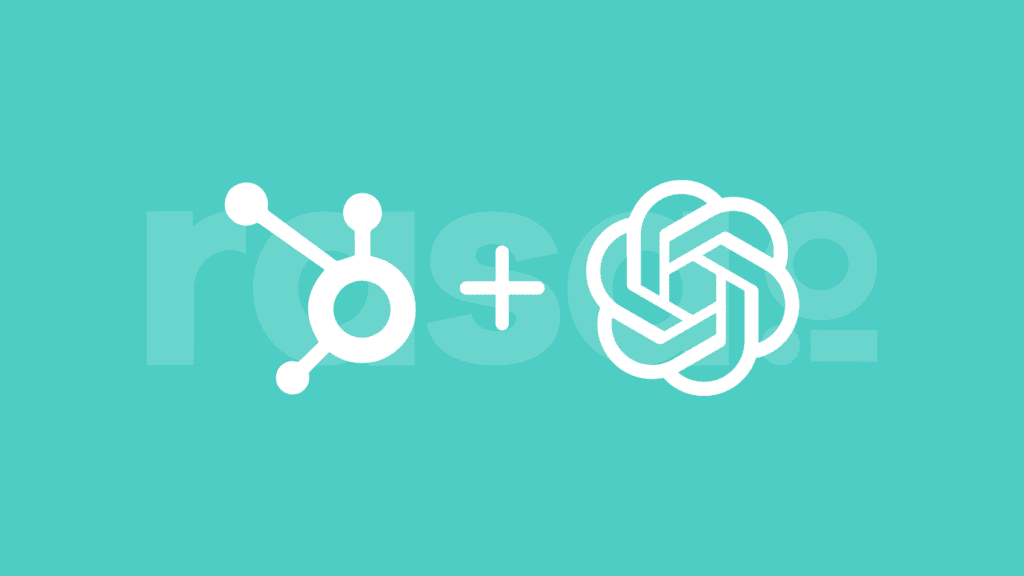Your organization’s member engagement newsletter is an incredibly valuable way to consistently engage your community. It’s also an effective way to show them how you stay ahead of the important topics and news in your industry. It also provides an opportunity to associate your organization’s brand with cutting-edge information in your space.
However, most organizations aren’t taking full advantage of this useful communication tool. So read on to explore 15 ways you can take your email newsletter to the next level.
First, you will identify ways to leverage new technologies to make your email newsletter more sophisticated. At the same time, these new technologies will create less of a drain on your internal resources. In other words, you’ll learn how to save a lot of time.
Second, you get some useful ideas for taking your newsletter to the next level and how you can maximize your newsletter real estate.
Finally, this list will conclude by ensuring that you leverage the fundamentals of email engagement for your newsletter.
3 tips for taking your newsletter to the next level
1. Personalize your news content
We all are beginning to understand the power of personalization. In this day in age, one-size-fits-all communication essentially equates to one-size-fits-none engagement practices. According to the market intelligence company, Aberdeen: “Personalized email messages improve click-through rates by an average of 14% and conversions by 10%.” And it’s no different for newsletters.
Hand-segmenting your list based on member interests, occupations, and interactive activities is one way to begin personalizing to increase engagement. You can send several different versions of your email newsletter based upon the historical data you have collected on your members. There are a variety of email tools designed for this kind of hand-segmentation.
However, the practice of hand-segmenting email newsletters has its downsides. First, hand-parsing Excel docs and hand curating several different versions of an email is extremely challenging and time-consuming.
Second, the member data that you currently have might be stale. Finally, even if the member data you have is current, people don’t always accurately self-report their interests.
For example, I may say that I am a marketer interested in reading about branding, but in reality, I might click on articles that focus on digital and SEO. How would you be able to keep timely tabs on my interests if I self-report my top interest is branding?
That’s where automation comes into play.
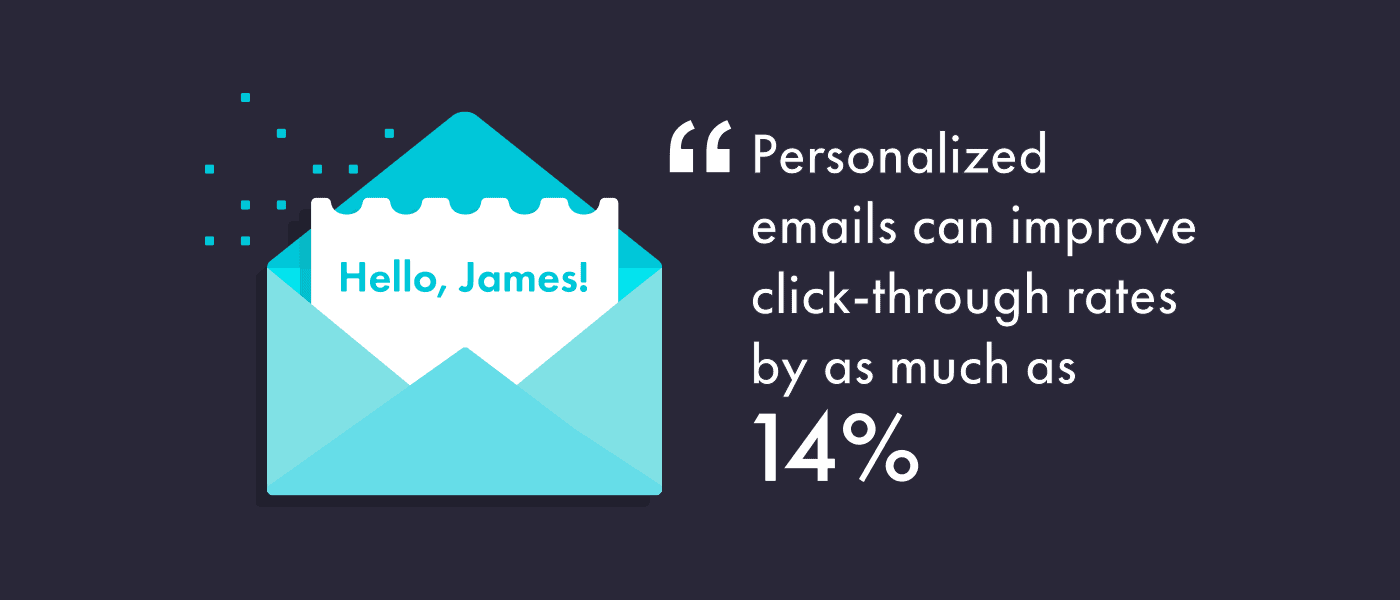
2. Automate the newsletter process
We all share one common yet scarce resource: time. Automating your email newsletter process can be one way to save your staff’s time. Automation generates results because you can engage with a new level of frequency without having to spend more time, effort or money.
With regard to newsletters, instead of scouring the internet for the latest, important industry news and hand-curating your email newsletter, stories from relevant, authoritative news outlets automatically pull into your emails to support an auto-send process.
While many people have considered automating the email newsletter process, one of the reasons they hold back is because they don’t want to sacrifice the margin of personalization and relevance they gain from hand-segmentation.
3. Optimize with artificial intelligence
How do you get personalization and automation in one place along with the added benefit of continually evolving intelligence for your newsletter? Well, with artificial intelligence or AI, of course.
Email services now exist that allow you to compile a list of credible news sources. On top of those, they include your organization’s own events, blogs, news, journals, and articles. That content auto-populates into individualized emails.
You can leverage AI to scan the content of hundreds upon hundreds of articles that come in from those sources. You can choose the specific stories to push to each reader’s email, according to their behavior, preferences, and AI insights you gather from other similar users. Imagine sending a unique email to every single one of your readers based upon just-in-time insights on their reading behaviors.
Maximize your newsletter real estate
Now that you have some ideas around leveraging innovative technology and automation for your newsletter, keep reading to learn the best practices for optimizing your email real estate.
4. Include links to your subscribe and/or membership renewal pages
At rasa.io, our clients and prospects often ask us, “Why do we need to include a “subscribe” link if people are already receiving our emails? Doesn’t that mean they are already subscribed?” The short answer is, yes, they are already subscribed, but it is best practice to include a subscribe link.
Here’s why:
If you send out engaging content, the chances are your members and subscribers will forward your emails to others. When those outside users consume the forwarded content from your email, providing them easy access to a “subscribe” link enables them to join your list with just one or two clicks.
However, depending on your email newsletter structure or strategy, you might not want to allow unregistered or non-member users to automatically opt into your newsletter list. Of course, this is understandable depending upon your organization’s processes.
In that case, you can direct them to a membership page or another landing page that will allow you to collect their information for whatever purposes you choose going forward.
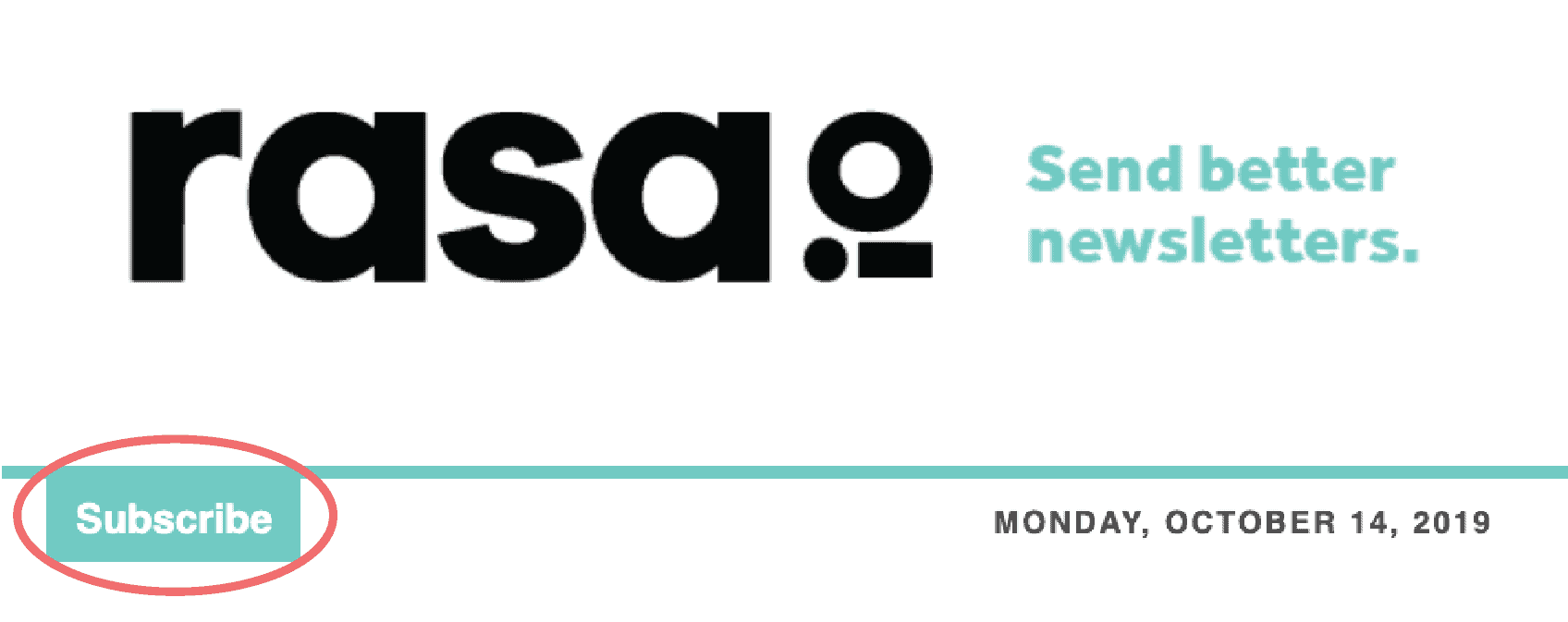
5. Make your social media profile info easily available
Whether it be in your footer or in your header, or via some other strategic placement in your email newsletter, you should always include links to your social profile pages.
That will allow users to easily click out and view the most up-to-date components of your online presence via your social pages. And if they have not already, it provides an easy avenue to follow or like your various pages.
6. Use a call to action for important events
Every experienced marketer knows you always need an effective call to action or CTA. Using CTAs is how you know you’ve made progress to reach your ultimate goal, whatever it may be. In most cases, with digital marketing and communications, you want one, clearly-defined CTA to move your audience members down a clearly defined path.
But for email newsletters, your CTA strategy should be a bit different. You want to inform your readers about the latest news and updates in your industry, but in a largely unbiased way.
It is still beneficial, however, to leverage your newsletter communications to separately promote your current goals. You can use some of your newsletter real estate to encourage members to sign up for your upcoming webinar, register for your conference, or renew their membership, for example.
7. Infuse other interesting and important messages
Along the lines of calls to action, you can also leverage your newsletter real estate to infuse other newsworthy and important messages. Many of our clients infuse daily lead text, as we at rasa.io like to call it, at the top of their newsletters to share their own editorial alongside the latest industry news.
You can use this editorial space to feature progress toward major goals, new hire information, board meeting updates, a highlight on a superstar member or volunteer, and the list goes on.
8. Highlight your organization’s key content
While creating quality content can be difficult, creating a lot of quality content is even harder. That is one of the reasons that we at rasa.io recommend aggregating your organization’s own content with other relevant industry news within your newsletter space.
This is one of the key strategies of content marketing and will alleviate some of the pressure to curate your newsletter. Adding in outside content enables you to send a content-rich newsletter without needing all the content within the email to be your own.
When your organization creates a quality blog, podcast, news or journal article, you want to make sure you highlight it within your email newsletter. Be certain to include some featured real estate in the email, such as a highlighted or boxed visual treatment, for example. Doing that will make it highly apparent whenever your organization publishes something new.
We find that when our clients infuse their own content into a visually-highlighted space, it gets greater engagement than it otherwise would with the same visual treatment as the rest of the stories. Watch our webinar on other tips and tricks for promoting your organization’s content.
9. Leverage promotional opportunities
Deciding whether or not to include paid advertisements in your news brief is multi-faceted. Some main things to consider include:
- The size of your audience.
- Your engagement rates.
- If there are advertisers who will market industry-appropriate goods and services.
- If you have a vendor or someone internally who can sell the ads.
If you decide to include paid ads, the obvious benefit is you will be able to monetize your email newsletter. Another benefit is that you can expose your members to the vendors and products they would not have been aware of otherwise.
Even if you make the decision to steer away from paid advertisements, you can still leverage advertising space for internal promotions. For example, find a graphic designer to create engaging promotional images that advertise the web pages you want to drive traffic to. They could include upcoming educational events or even external educational resources that you feel are appropriate for your company, organization or community.
10. Incorporate “evergreen” content
It makes sense to primarily include the latest, breaking news in your newsletter. However, sometimes there might be a piece that is relevant to your subscribers that might have been published months or even years ago. Content that stays relevant and useful over time is “evergreen.”
If you are interested in having historic, evergreen content pull in from journals or other reputable online publications, like the Harvard Business Review or The New England Journal of Medicine, for instance, you can include those sources in your list of content feeds, as well. You can also leverage artificial intelligence to only bring in an evergreen piece when it is particularly relevant to an individual reader.
Optimize the fundamentals of your email newsletter communication
You’ve learned some tech tips and email newsletter real estate optimization, but that’s not all. Keep reading to find out about the fundamentals of email communication. It’s time to delve into what our data and the data of some other big players in the space point to when it comes to optimal subject lines, send times and send days, as well as the preview text and send frequency.
11. Optimize your subject line
Why is the subject line so important? Without an effective subject line, the content within your a newsletter has little chance of being consumed. Here are five ways to help you craft effective subject lines, along with some examples:
- Add numerical lists of tips, tricks, value propositions. For example, 7 Reasons to Embrace Artificial Intelligence or 8 Great AI Tools.
- Offer recent news headlines or relevant announcements. Oftentimes at rasa.io, when we use AI to choose the most relevant subject line for each individual reader, we bring personalization to the next level. This significantly increases the chances that the recipient will open the email. Plus, we can then depend on the content specialists who have written those news headlines to write something enticing.
- Include personalization tags. For instance, you could use Top industry headlines for Erica. People are up to 50% more likely to open an email when you personalize the subject line with one of their individualized attributes.
- Ask intriguing questions to pique your reader’s interests. Some examples include, “Are you wondering how to stay ahead of your marketing tasks?” or “Are you having trouble retaining your customers?”
- Use action-oriented language and commands to imply deadlines and scarcity. This is a great way to drive open rates. For example, “Register by August 1 to take full advantage of this offer.”
12. Choose a send day
Choosing the day or days to send your newsletter is a decision that profoundly impacts overall email engagement. That is, if you don’t send your digest out every day as a way to maximize engagement. You’ll learn more about that in the Send Frequency section.
As the Mailchimp graph below demonstrates, Tuesdays and Thursdays tend to be optimal send days. They are followed by Mondays and Wednesdays, and then by Friday. And, in dead last are weekend days.

13. Consider your newsletter send time
Email send time is also a critical engagement determiner. It is a common misconception that if you send on a good day, your readers will just open the email newsletter at their convenience, but it doesn’t quite work that way.
The truth is that an email is five times more likely to be opened within an hour of its send time, so you need to consider the hour of the day. But you also need to consider the time zone(s) of residence of the majority of your members, clients, and subscribers.
According to the chart below by CoSchedule.com, the top four send times are 10 am, 8 pm, 2 pm, and 6 am. Those optimal times confirm that for better or worse, people go to bed as well as wake up with their inboxes.
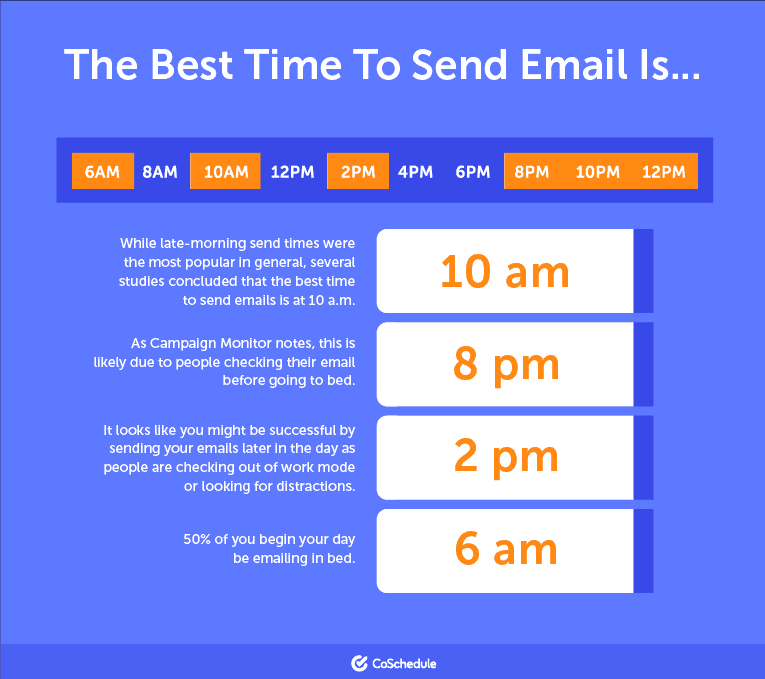
14. Decide on send frequency
You can send your newsbrief daily, two or three times per week, once a week, twice a month, or however often you like. We often recommend sending daily or multiple times per week so that our rasa.io artificial intelligence can best learn about each individual reader’s preferences. Sending multiple days per week also maximizes your unique weekly engagement rates.
In other words, you can maximize the chances that you will reach each of the members of your audience on any given day. That’s because even if you have lots of engaging content on optimal send days, every individual’s schedule and read-day preferences are different. However, if your industry is extremely niche, it might be best to send your newsletter less frequently. This is especially true if there is not as much daily news for your particular industry.
15. Craft appropriate preview or pre-header text
Many mail clients incorporate preview text into their interfaces these days. What is preview text, you ask? It is the snippet of content that appears after the subject of an email before you even open it to see what is inside. It’s critical to take advantage of this extra real estate that some email clients allot.
If you don’t craft your own custom preview text, it will normally default to the first sentence or so of your email. However, many email send services allow you to customize your preview text. At rasa.io, we recommend customization because it allows you another chance to intrigue your reader and encourages them to open your email.

Conclusion
These are the 15 ways to bring your newsletter to the next level. You now know about some of the innovative, personalizing and time saving technologies you can use to improve the content within your newsletter. You can now get busy spreading your newsletter with the email send best practices you have learned.

